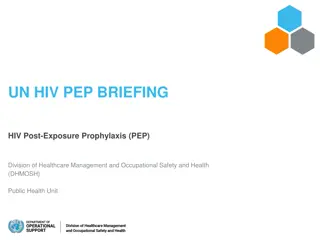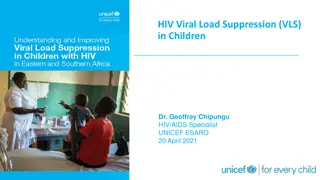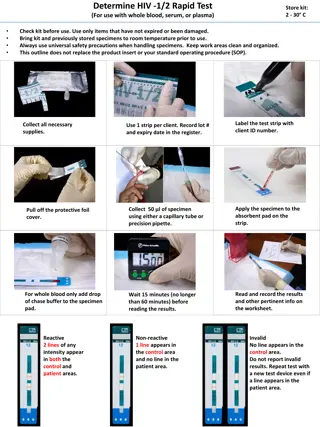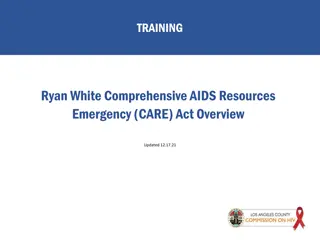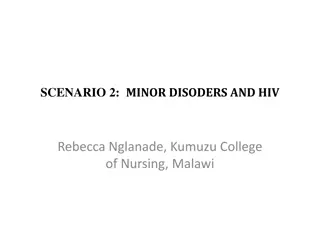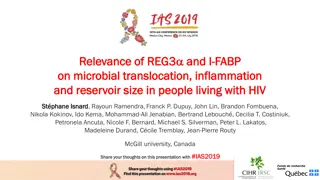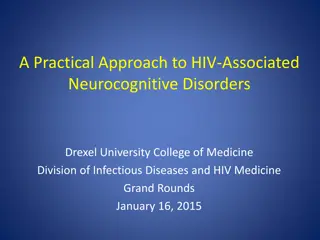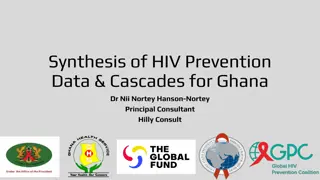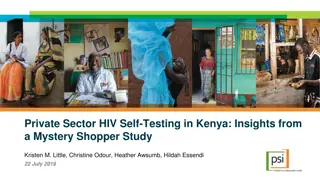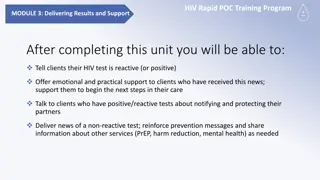
Neurological Presentations of HIV in Clinical Practice
Explore the neurological manifestations of HIV through a case study, differential diagnoses, and diagnostic procedures like lumbar puncture. Learn about the unique challenges faced in diagnosing and managing HIV-related neurological complications.
Download Presentation

Please find below an Image/Link to download the presentation.
The content on the website is provided AS IS for your information and personal use only. It may not be sold, licensed, or shared on other websites without obtaining consent from the author. If you encounter any issues during the download, it is possible that the publisher has removed the file from their server.
You are allowed to download the files provided on this website for personal or commercial use, subject to the condition that they are used lawfully. All files are the property of their respective owners.
The content on the website is provided AS IS for your information and personal use only. It may not be sold, licensed, or shared on other websites without obtaining consent from the author.
E N D
Presentation Transcript
What is the neurological presentation of HIV? ROZITA KHODASHAHI ID SPECIALIST,FELLOWSHIP IN IC HOST & TRANSPLANT PATIENT ASSOCIATE PROFESSOR MASHHAD UNIVERSITY OF MEDICAL SCIENCES
CASE CASE PRESENTATION PRESENTATION A 29-year-old man(sexually active) was admitted to our hospital with a one-month history of weakness of the left lower extremity and a tingling sensation in the right foot. On a physical examination, he was found to have a normal level of consciousness, and the cranial nerves and upper extremities showed no focal neurological deficits. However, left lower extremity weakness was apparent, and the tendon reflexes in the left knee and ankle were absent.
DIFFERENTIAL DIAGNOSIS DIFFERENTIAL DIAGNOSIS
Transverse myelitis Miller Fischer syndrome Toxic polyradiculopathy: Anti-PD1 agent like pembrolizumab in metastatic melanoma, late sequelae of ethylene glycol intoxication, a late adverse reaction of chemo-radiotherapy, post intrathecal injection of methotrexate. Inflammatory polyradiculopathy Leptomeningeal carcinomatosis Neurosarcoidosis Neurobrucellosis HIV PRP
CASE CASE PRESENTATION PRESENTATION ACE:Nl ANA Profile:Nl RF:Nl Wright/2ME:Nl CBC:Luekopenia/lymphopenia DH:Negative
CASE CASE PRESENTATION PRESENTATION HIV screening test was positive, with an HIV-1 RNA level of 4.6 104copies/mL and CD4+ cell count of 80/ L.
LUMBAR PUNCTURE LUMBAR PUNCTURE Pleocytosis with polymorphonuclear leucocyte predominance Hypoglycorrhachia Increased protein levels
DIFFERENTIAL DIAGNOSIS DIFFERENTIAL DIAGNOSIS
CASE CASE PRESENTATION PRESENTATION CSF analysis showed a WBC count of 291/ L, with 62% of Polymorphonuclear leukocytes, as well as a protein level of 269 mg/dL and glucose level of 31 mg/dL. Cryptococcus antigen assay bacteria,mycobacteria and fungi were negative and cultures for
Lumbar spine MRI performed without contrast showed no abnormalities Lumbar spine CE-MRI showed contrast enhancement in the cauda equina predominantly on the left side
On day 2, the CSF CMV DNA level was 2.0 109 copies/mL. ophthalmologic examination were done
Misdiagnosis and underdiagnosis of HIV-1-associated radiculopathy are common. Consequently, HIV-associated progressive polyradiculopathy has 100% mortality without prompt diagnosis and treatment. CMV-associated polyradiculopathy is rapidly fatal without treatment, but the mortality for this particular form is as high as 22% even with treatment
CASE CASE PRESENTATION PRESENTATION Treatment with ganciclovir (5 mg/kg every 12 hours) was therefore administered. Consequently, the patient s abnormal sensation in his right foot and difficulty in urination were ameliorated, and his strength in the left lower extremity gradually improved. Thereafter, ART consisting was initiated
CASE CASE PRESENTATION PRESENTATION A CSF sample obtained on day 22 revealed a CMV DNA level of 4.0 103 copies/mL, and, the CMV treatment regimen was stopped. The patient s left lower extremity strength subsequently improved, such that he was able to walk by himself with the help of a cane, and he was discharged on day 33.
In HIV patients with CMV-PP, intravenous ganciclovir administration for 2 to 3 weeks is the first-line treatment for severe disease. If the patient gives a history of previous monotherapy for similar or different CMV manifestations or if the serial CSF reading shows persistent pleocytosis and hypoglycorrhachia after induction of ganciclovir therapy, the likelihood of treatment failure is high, and treatment with alternative drug or ganciclovir- foscarnet combination should be considered.
In patients with a CD4 count of fewer than 100 cells/microliter or CMV viremia or previous history of CMV infection, asymptomatic fundoscopic screening is recommended.
CMV neurologic disease is diagnosed on the basis of a compatible clinical syndrome and the presence of CMV in CSF or brain tissue, most often evaluated with PCR. Blood tests to detect CMV by antigen detection, culture, or PCR are not recommended for diagnosis of CMV end-organ disease because of their poor positive predictive value in people with advanced AIDS. . A negative serum or plasma PCR assay does not rule out CMV end-organ. Monitoring for CMV viremia is not recommended.
Thank You!




